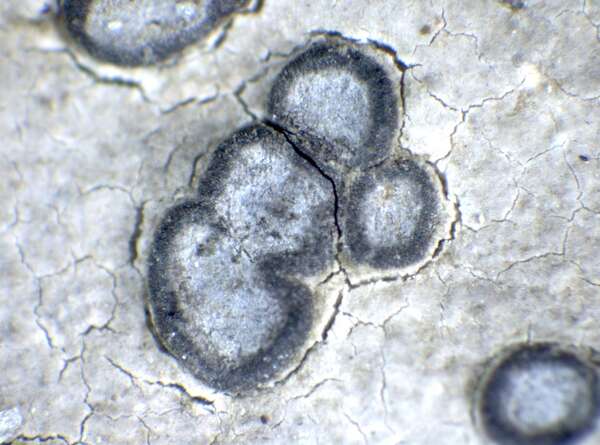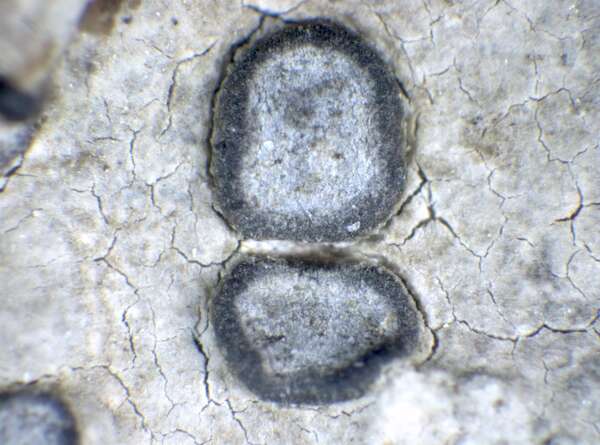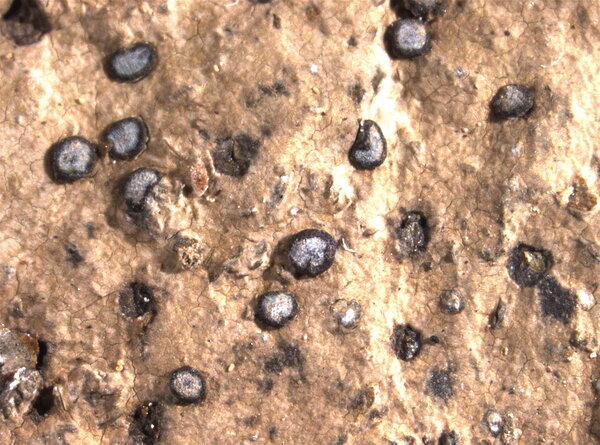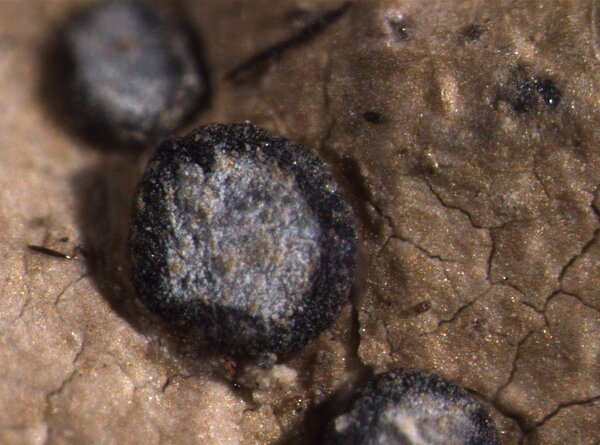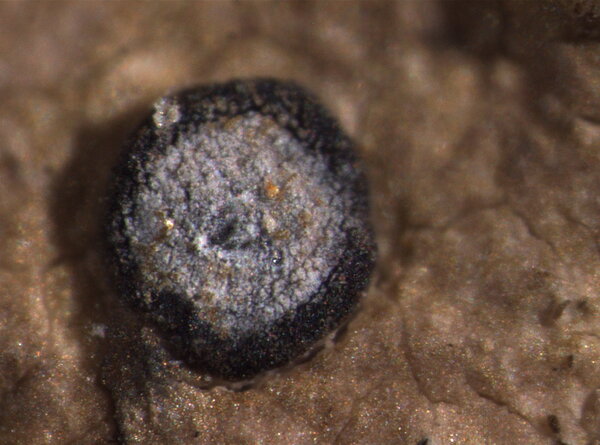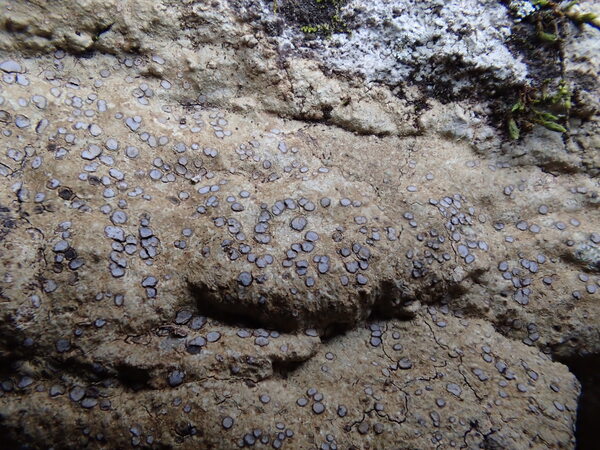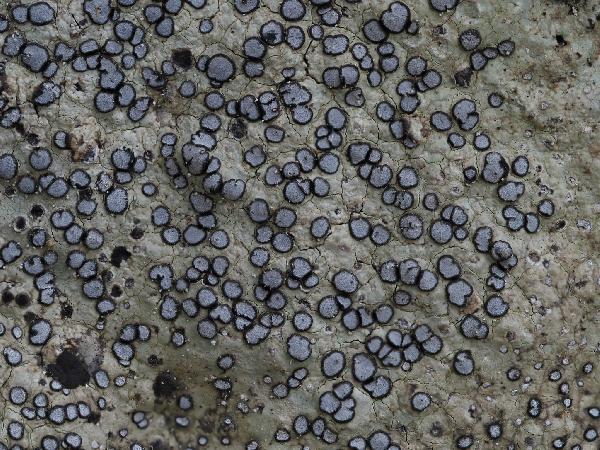Porpidia albocaerulescens (Wulfen) Hertel & Knoph
Mitt. bot. Staatss. München, 20: 476, 1984. Basionym: Lichen albocaerulescens Wulfen in Jacquin - Collect. Bot., 2: 184, 1791 (1788).
Synonyms: Haplocarpon albocaerulescens (Wulfen) M. Choisy; Huilia albocaerulescens (Wulfen) Hertel; Lecidea albocaerulescens (Wulfen) Ach. nomen sed non planta; Lecidea alboflavescens Vain.; Lecidea nitescens Leight.
Distribution: N - VG, Ven, TAA, Lomb, Piem (Isocrono & al. 2004), VA (Piervittori & Isocrono 1999, Matteucci & al. 2015c), Lig. C - Tosc, Sar (TSB 8890). S - Camp (Ricciardi & al. 2000), Cal (Puntillo 1996).
Description: Thallus crustose, episubstratic, 0.25-0.4 mm or rarely up to 1.5 mm thick, dirty white, pale greenish grey to dark olive-grey, continuous or very finely rimose, forming very large, up to 40 cm wide patches, sometimes delimited by a very thin, dark prothallus. Some very rare forms are sorediate, the soralia rounded, slightly convex, concolorous with the thallus or brighter and whitish grey. Medulla white, I-. Apothecia lecideine, (0.4-)0.6-1.5(-2.5) mm across, usually numerous, immersed in the thallus, rarely later becoming subsessile, with a black, thickly white- or grey-pruinose, usually flat, sometimes slightly convex disc, and a thin, epruinose, raised proper margin. Proper exciple 60-95-135 µm wide, with a dark-pigmented cortex and a pale medulla of 1.8-4.2 µm thick filamentous hyphae, K+ yellow; epithecium olivaceous to brownish grey, with granules, N+ orange, K-; hymenium colourless, (75-)90-120(-135) µm high, I+ blue; paraphyses coherent, mostly simple and anastomosing, 1.4-2 µm thick at mid-level, the apical cell 2.5-3.5 µm wide; hypothecium blackish brown, (75-)90-200(-300)µm high. Asci 8-spored, elongate-clavate, with a thin, outer amyloid layer and a thickened tholus penetrated by a pore, the sides of which are strongly amyloid, Porpidia-type. Ascospores 1-celled, hyaline, ellipsoid, (15-)18-27(-32) x (6-)7-12(-14) µm. Pycnidia immersed. Conidia bacilliform, 6-11(-14) x c. 1 µm. Photobiont chlorococcoid. Spot tests: thallus K- or K+ pale yellow, C, KC-, P- or P+ pale orange; medulla K+ orange-yellow or (rarely) K+ yellow turning red, P+ orange. Chemistry: stictic acid (major) cryptostictic acid (minor), rarely also norstictic acid (major) and connorstictic acid (minor). Note: on siliceous boulders in sheltered, humid situations, such as in deciduous forests. Several earlier records reported by Nimis (1993: 566) and not checked by Hertel, are not accepted here.
Growth form: Crustose
Substrata: rocks
Photobiont: green algae other than Trentepohlia
Reproductive strategy: mainly sexual
Most common in areas with a humid-warm climate (e.g. most of Tyrrenian Italy)
Commonnes-rarity: (info)
Alpine belt: absent
Subalpine belt: absent
Oromediterranean belt: absent
Montane belt: very rare
Submediterranean belt: extremely rare
Padanian area: absent
Humid submediterranean belt: rare
Humid mediterranean belt: extremely rare
Dry mediterranean belt: absent

Predictive model
Herbarium samples
Growth form: Crustose
Substrata: rocks
Photobiont: green algae other than Trentepohlia
Reproductive strategy: mainly sexual
Most common in areas with a humid-warm climate (e.g. most of Tyrrenian Italy)
Commonnes-rarity: (info)
Alpine belt: absent
Subalpine belt: absent
Oromediterranean belt: absent
Montane belt: very rare
Submediterranean belt: extremely rare
Padanian area: absent
Humid submediterranean belt: rare
Humid mediterranean belt: extremely rare
Dry mediterranean belt: absent

Predictive model
| Herbarium samples |
 INDEX FUNGORUM
INDEX FUNGORUM
 GBIF
GBIF
 DOLICHENS
DOLICHENS
